August 9, 2015
Martha O'Kennon
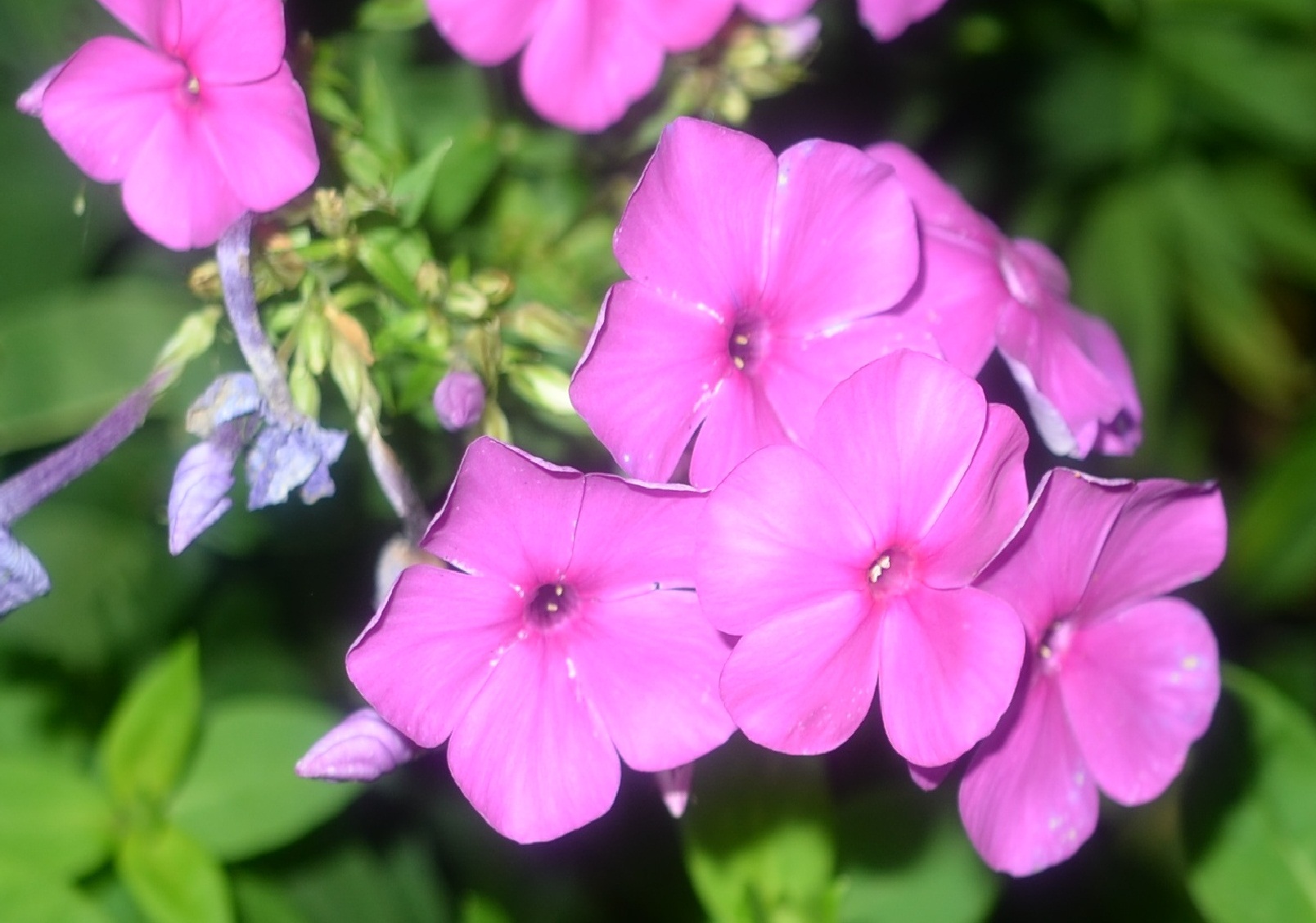
The summer flowers are waning. This is ordinary old garden phlox, but a shorter variety, one of the last of the summer. The trumpet vine is about to give up the ghost, and along with it its hoard of bees and wasps. But every day the goldenrod and asters become closer to blooming. They will be the last of the fall flowers but they stay with us for many weeks. Keep your eyes peeled for them.
Remember that there is information in the name of the file for each image. You can see it by mousing over the image - look at the lower left of the screen.
Or you can click on the image to get to the (usually) larger image. Then the info is displayed in the address line above. If the image has been cropped
so that clicking on it doesn't result in a larger picture, you can always hit control plus at the same time to increase the size.
Another week has gone by, and that includes another week for the caterpillars. They really keep me hopping - but it's worth it to see (so far) ALL of them still thriving. When I saw this nice green fat caterpillar, I told myself that must be one of the late-hatchers just undergoing the first moult, but a day or two later most of them showed signs of moulting themselves into instar 3. The last picture shows one of the babies just over a dime. Until a couple of days ago a dime was too big, then just right, and now MUCH smaller than the length of the typical caterpillar.

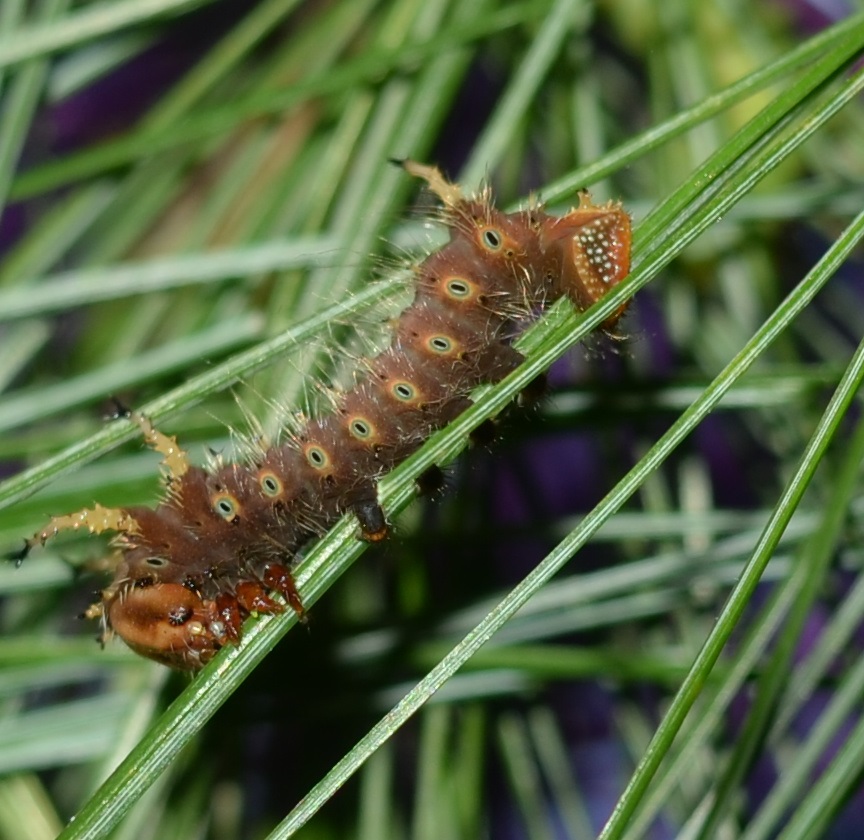
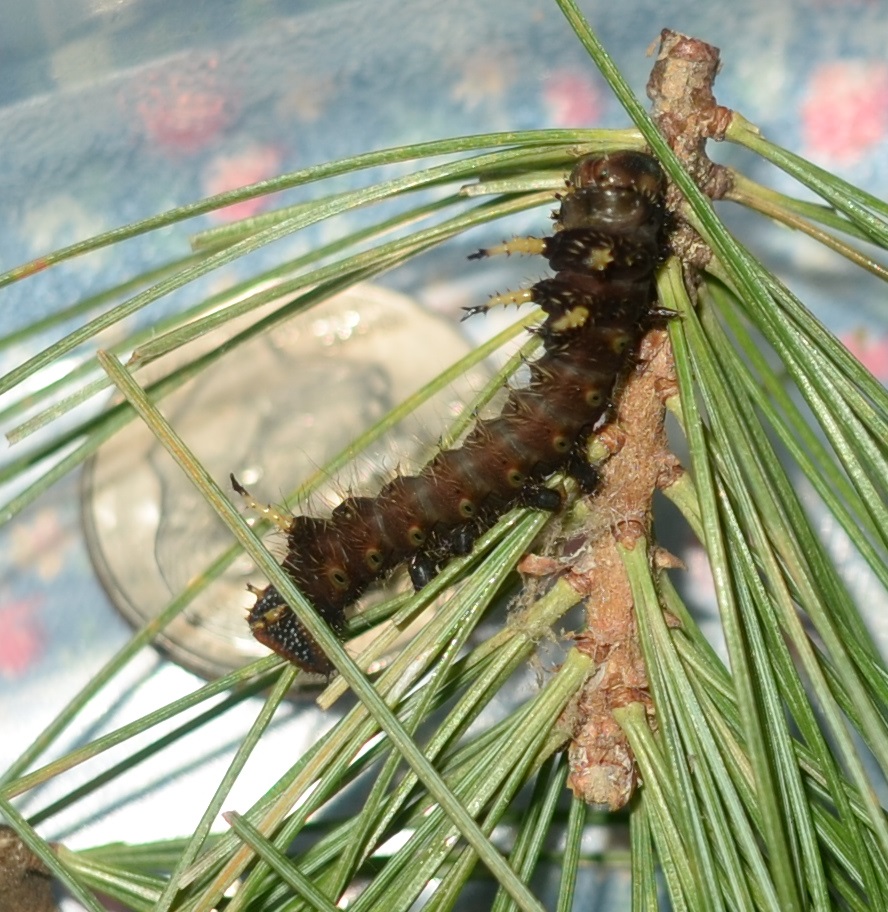
Maybe you will indulge me a little, but this was a wonderful week for treehoppers. It seems that one of the places they like to sun themselves is near the top of a tiger lily plant. That's where this first green buffalo treehopper (Ceresa genus) surprised me the other day. Is that a leaf mimic or what! And that's where I've had some luck finding the two other flavors of Ceresa. The second picture is a full frontal face view of Ceresa diceros (Greek for two-horned), then a side view, then Ceresa albescens (Latin for becoming white). Note that some of these are on raspberry, an alternate favorite resting place.
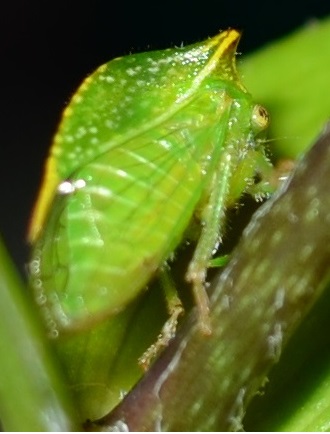
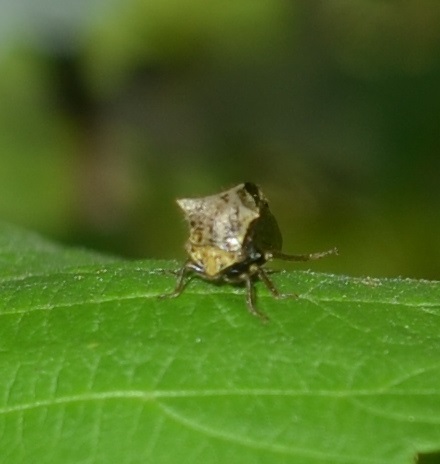
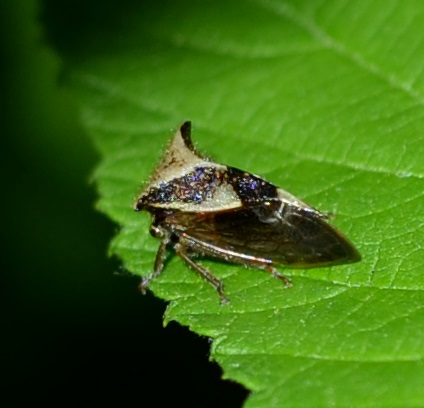
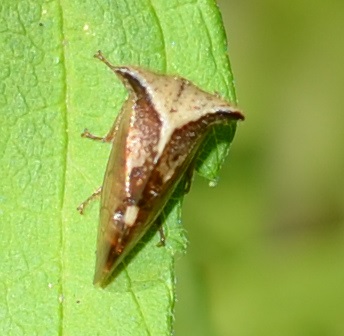
Of course, the other places we've seen treehoppers are the redbud tree, where we've seen a goodly number of two-mark treehoppers (Enchenopa on-cercis). That last little bit (on-Cercis) just means "on Redbud". In this first picture, of course, showing that everything breaks some rule or other, that two-mark is on a Tiger Lily! Well, one day this week, among the two-marks and their eggs, I spotted this interesting other model, genus Telamona. And on the other side of the house, in the weedpatch, on the most enormous thistle plant, we've been following the Entylia carinata, a two-humped treehopper. Here when I say "two-humped", that is are very recently out of the nymphal skin. To sum up, we've now seen six kinds of treehoppers, not all on trees.
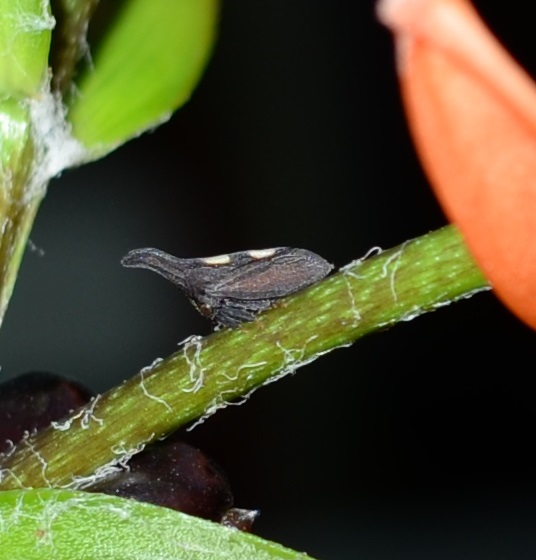
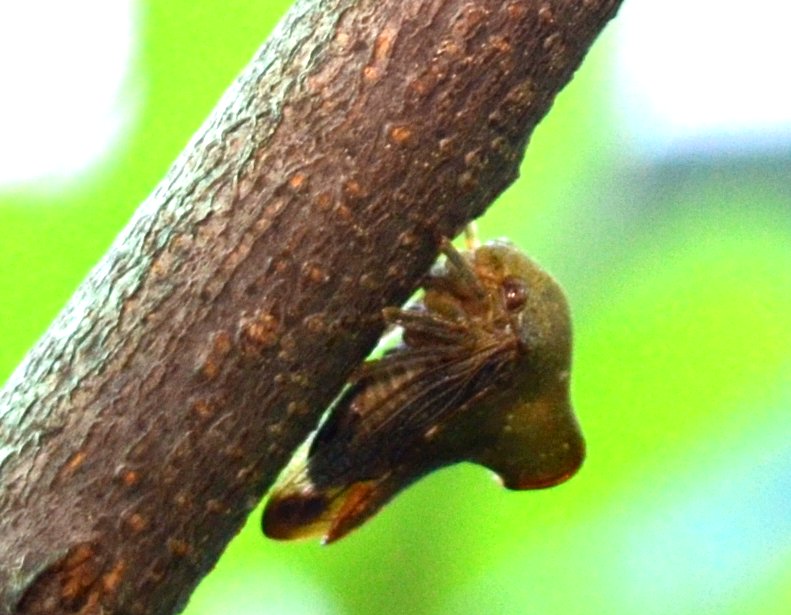
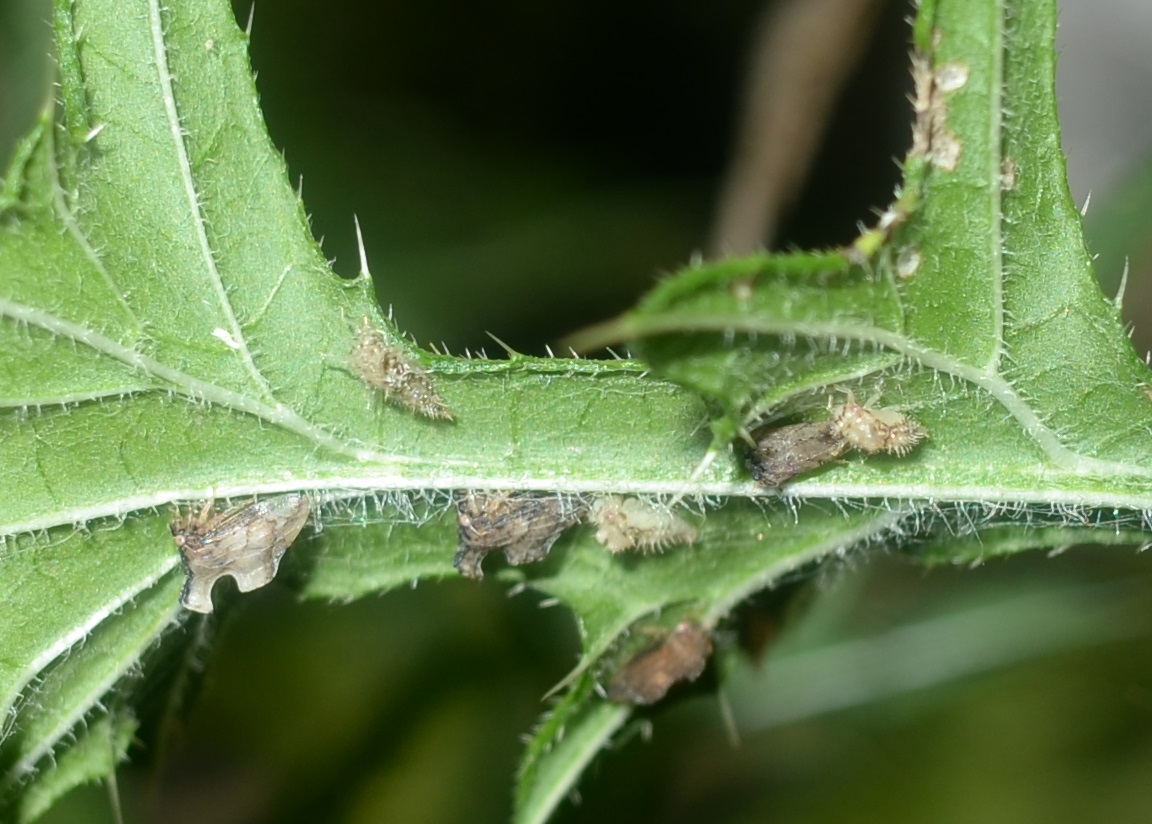
New leafhoppers also kept coming out. Most of them are very small, and many less than 6 mm (about 1/4 inch). The first is the Japanese Maple Leafhopper., then our old friend the candy-striped leafhopper, a bright green one, and a white one. I believe we have seen the last two a few times, OR there are several genera of these plain-looking leafhoppers.
 on lantana- 8 3 15 1a.jpg)
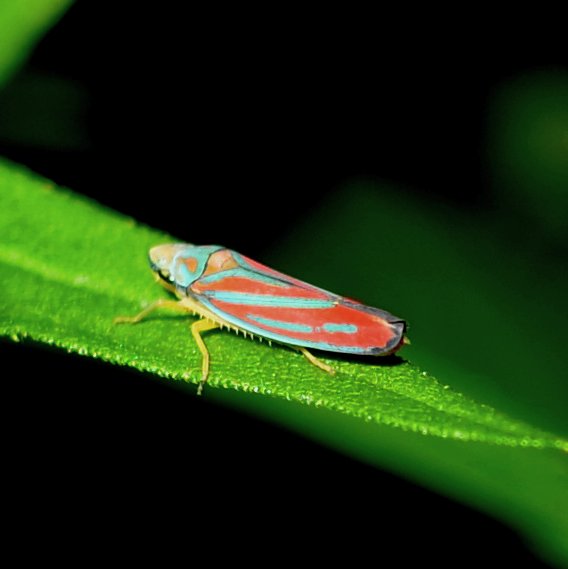
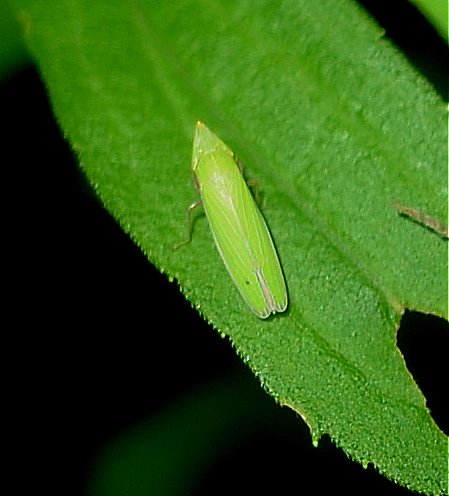
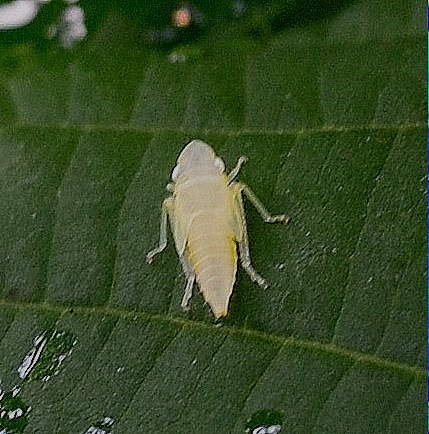
By far the most interesting of the leafhoppers this week were the Coelidia. They tend to sit back on their haunches,sometimes resembling a "micro-frog", and come in a plethora of colors and patterns. Their eyes are large for such a small (3 mm) insect (what we have here is a nymph). This one (sitting on a coneflower petal) looks so sad I named him "Oliver". You can almost hear him saying, "Please sir, I want some more." Both those images were lightly sharpened, as was this photo of a differently colored one sitting with its back to us. The last one is still not identified, even down to leafhopper, so I have some work cut out for me - later!


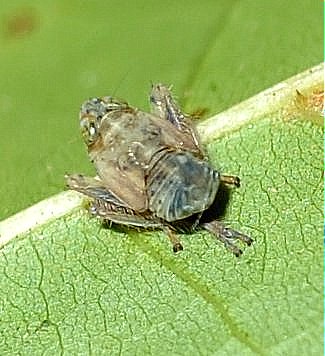

The other bug we saw over and over was a little (<6 mm) assassin bug nymph. I seem to be able to spot smaller and finer patterns. There's no doubt ths is one of the Zelus luridus nymphs, and later the adult. This grey stink bug we have seen before. Coincidentally, one of you posted me this adult cicada, and I had just found this nymphal shell on a neighbor's milkweed.
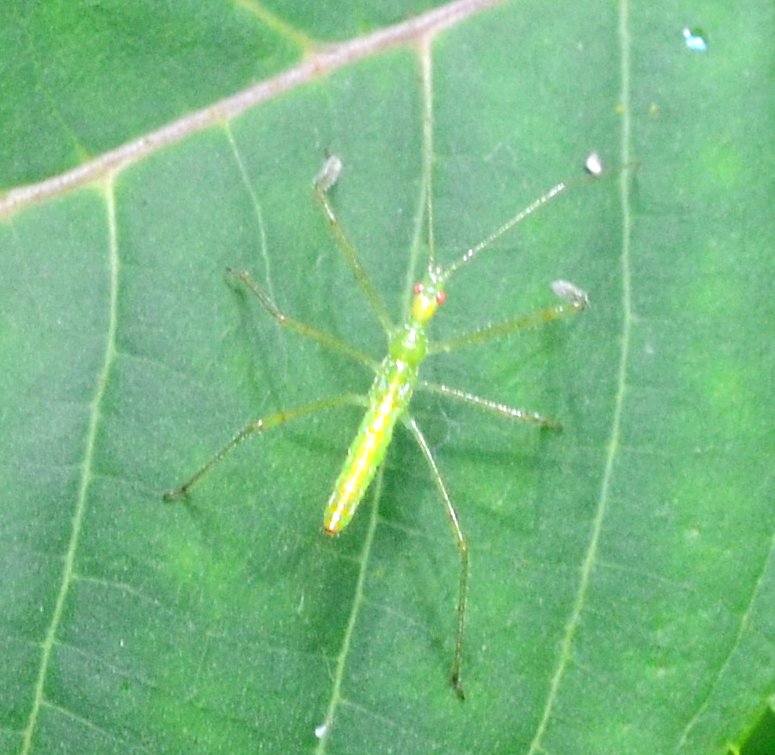
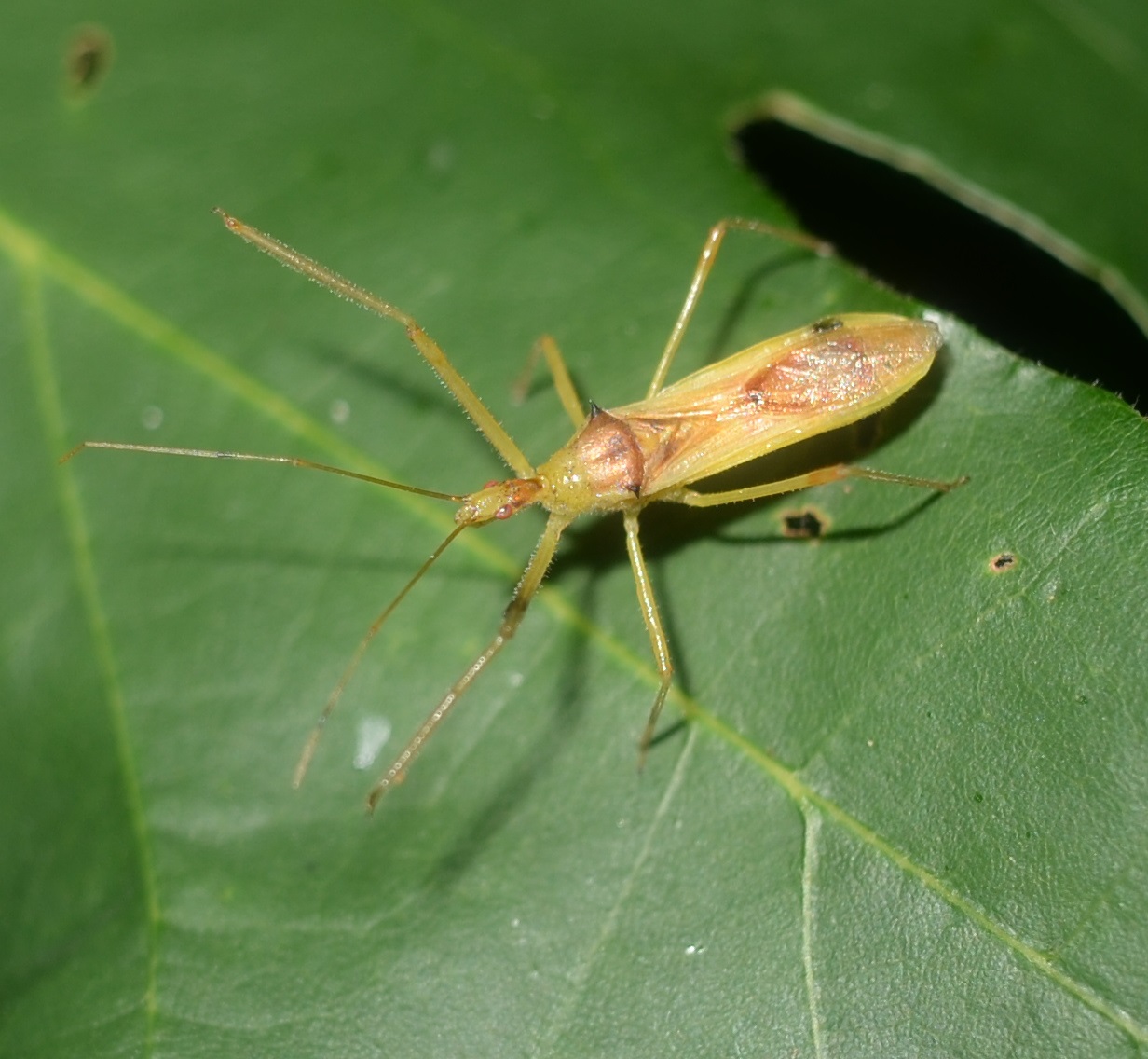
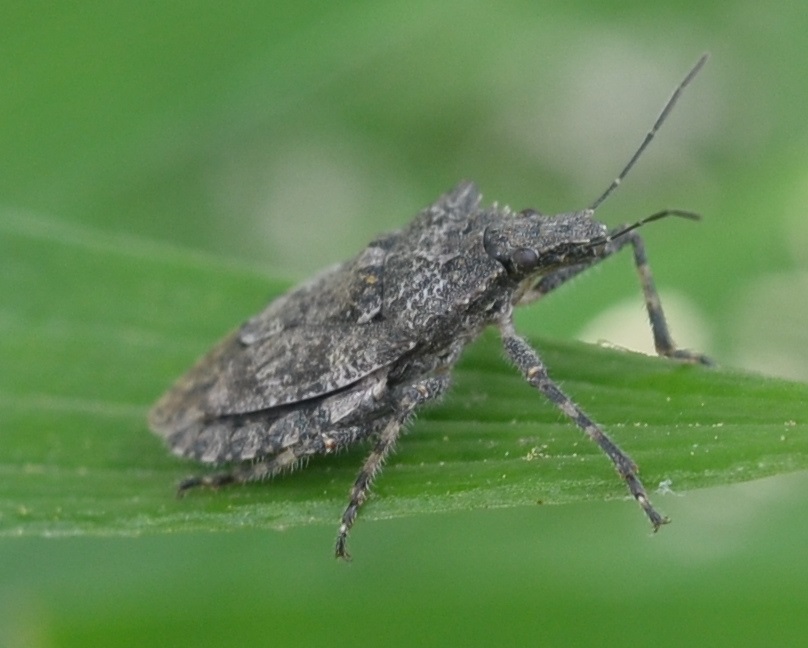
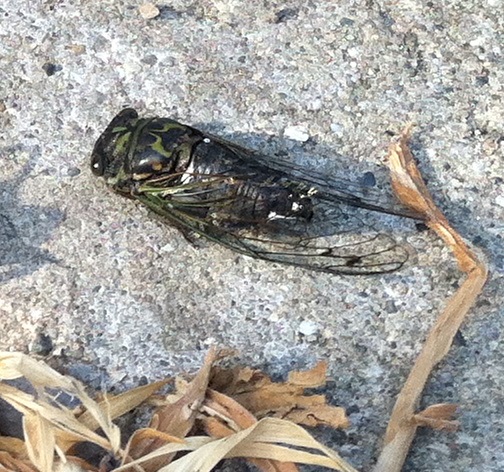
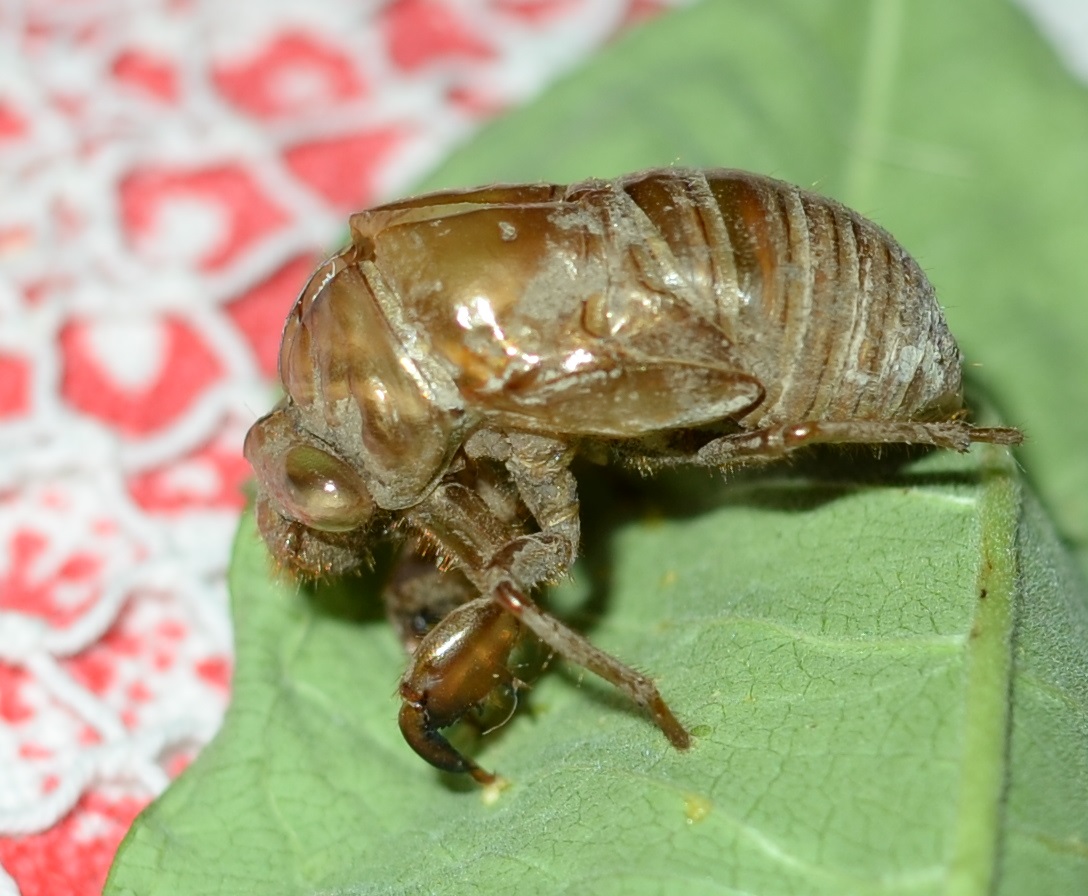
There was one of those brightly patterned green stink bugs but it was way down below me on the shop wall and so my picture is junk. But another lovely huge insect was in the mail from one of you. It's a dobsonfly and belongs to the order Neuroptera, meaning nerve-winged. Keep your fingers out from between those pincers! There was one dainty brown=marked damselfly. Its wings look disabled but it was gamely flying to and fro in short bursts. It also seems to have been able to snatch a small insect (in its mouth). Here we see the orangish dragonfly again. I'm wondering if this really is the kind with the reddish mate, which hasn't shown up in all this time. We'll have to keep our eyes wide open now.
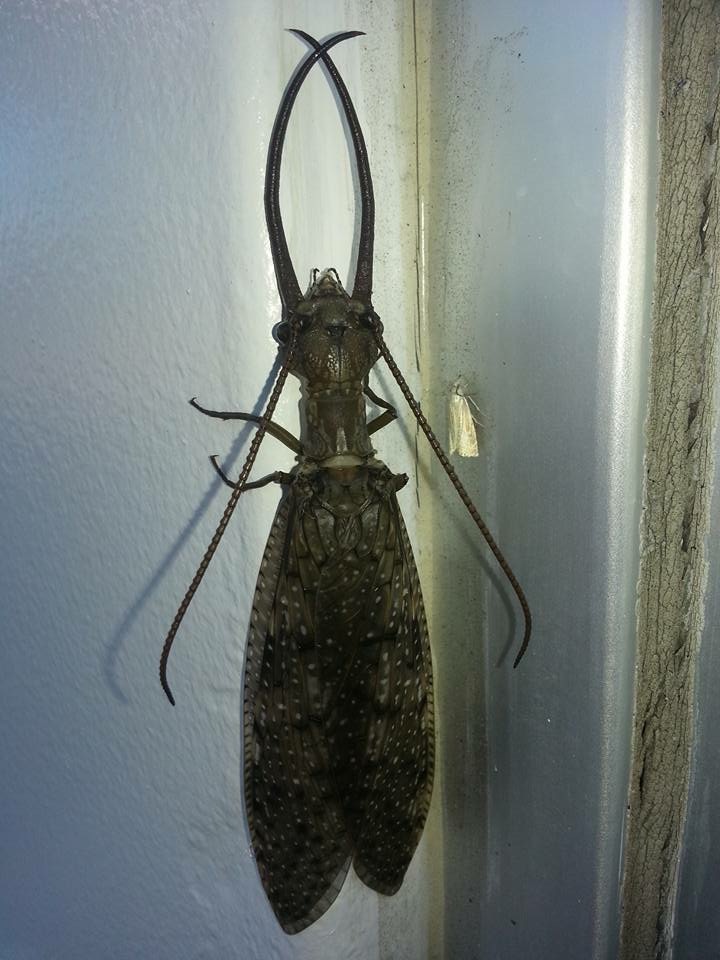
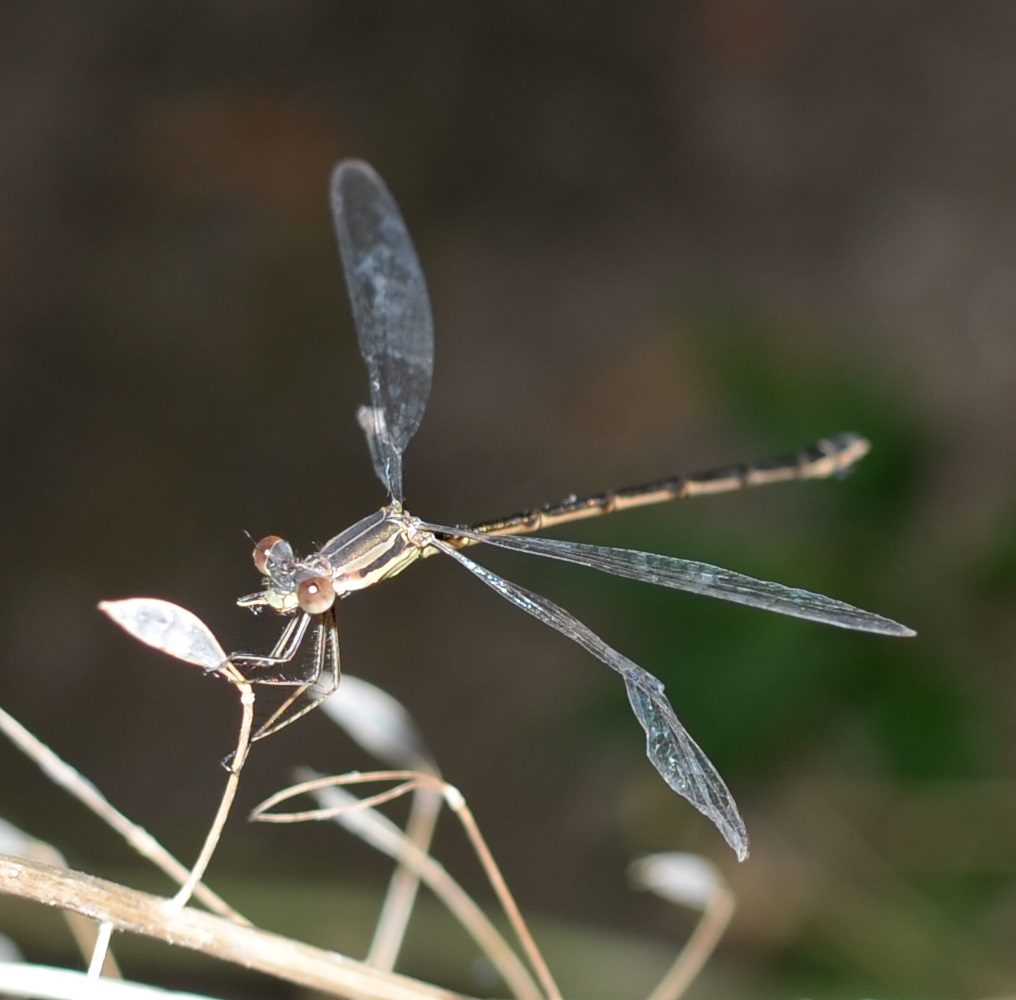
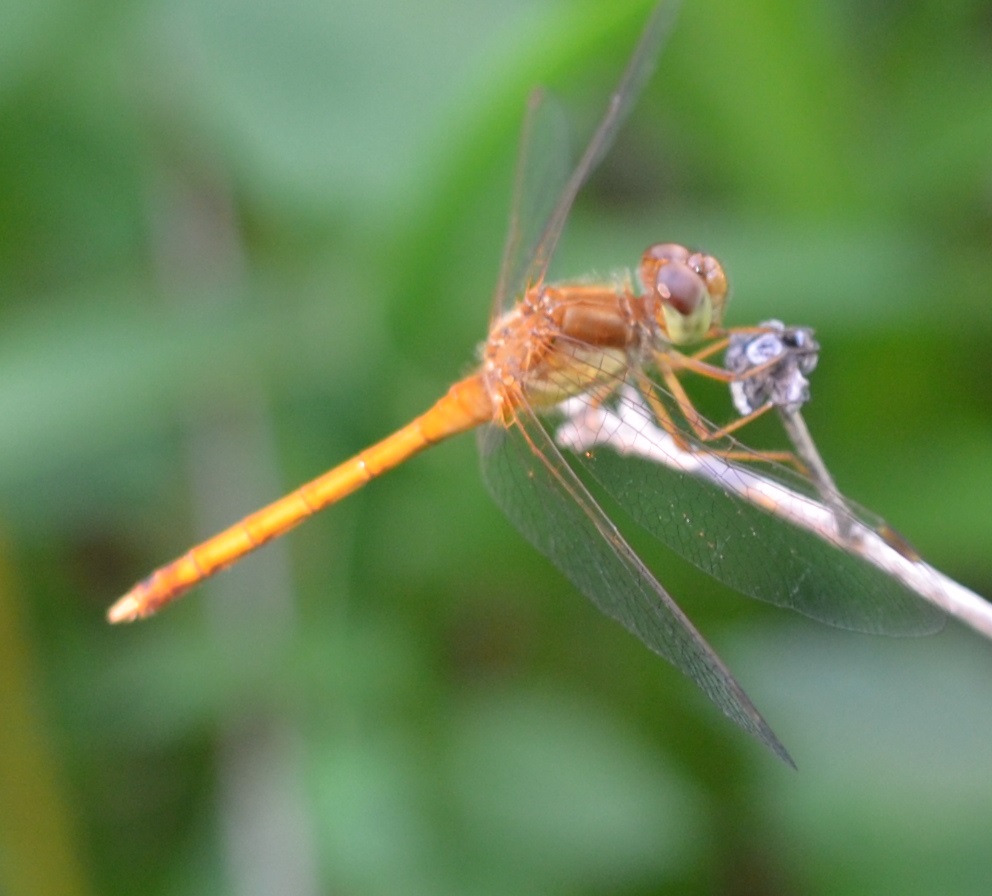
Let's call the roll of the hymenoptera: ants, bees, wasps, ichneumons, sawflies, etc. This nice ant (about i cm) was on the shop wall. The black and white "bee" is most likely a "bald-face hornet" (Dolichovespula maculata), which is really a black and white yellowjacket. You will probably not get stung by this one as it is such a scaredy-cat around people. The next picture is from last week's collection. The thistle tree attracts many bees - here is a small bumble-bee colored one, and then a mason bee. Apparently the mason bees, which collect pollen on their abdomens, are 20 times as good as honeybees for pollination. You can easily fashion a little house for them out of dowels (drill them with a 5/16 inch interior diameter) glued together. Oh! The one downside to mason bees is they don't produce large amounts of honey.
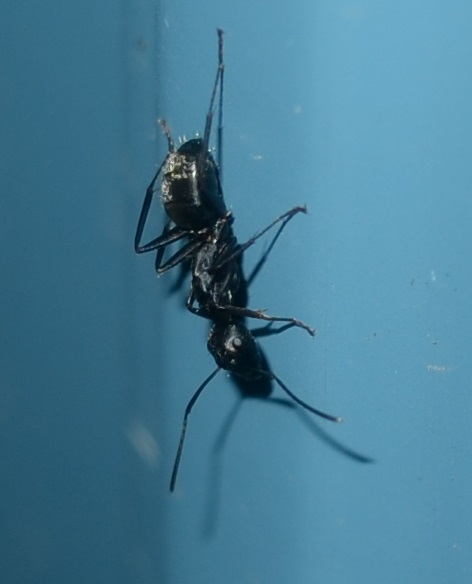
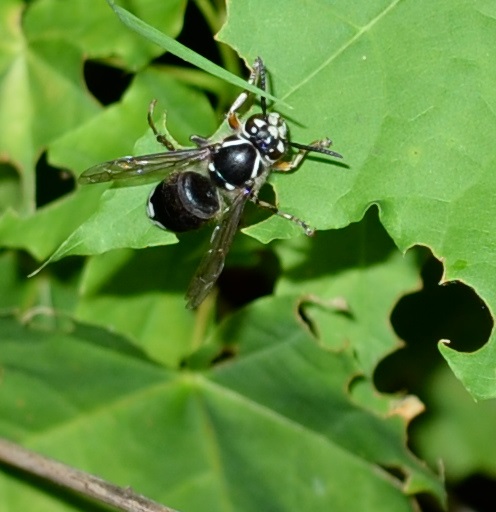
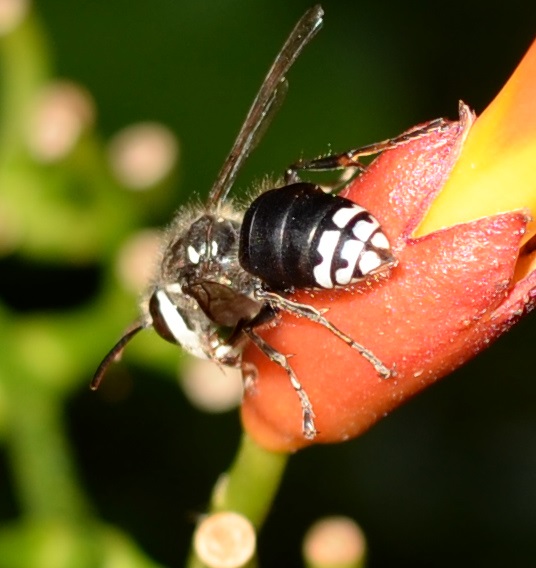
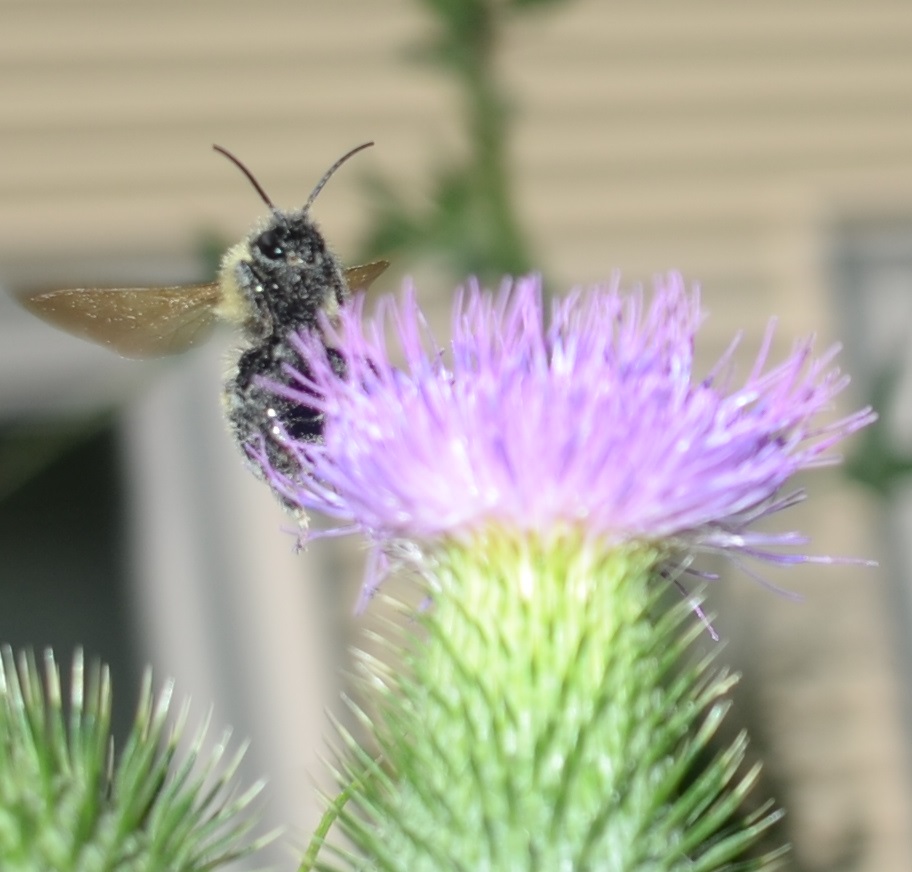
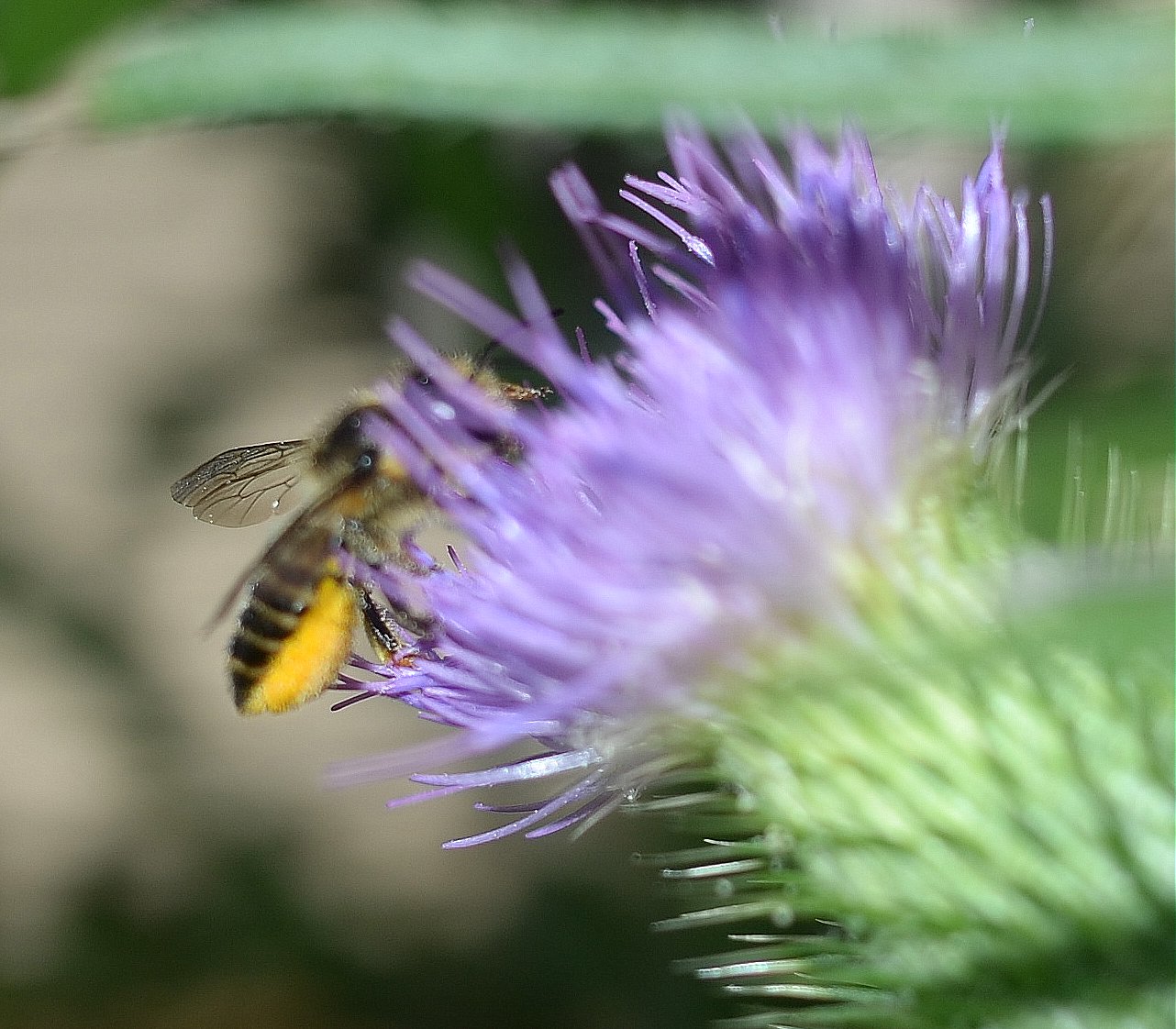
This little bee seemed to be comfortable on the coneflower petal. Another handsome black shiny one is on a tree leaf. Next is a mysterious little metallic one, and one so small you only see a flash of the most beautiful blue-green (which almost matches my house color).
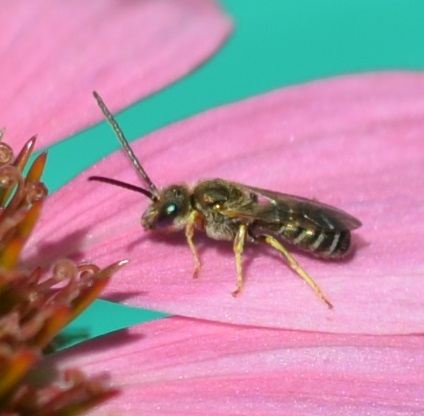
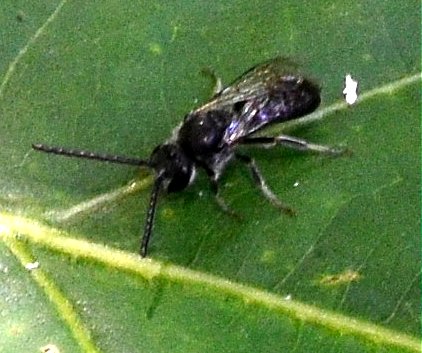
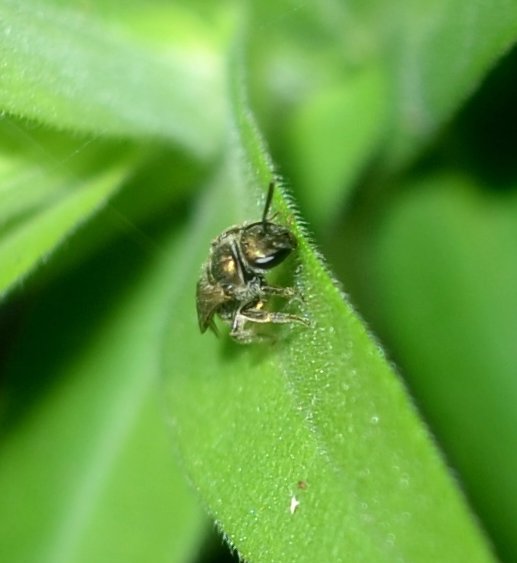
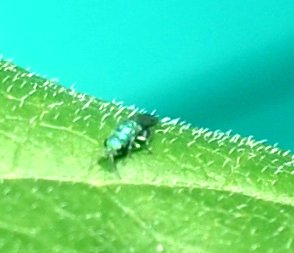
My favorite bee is the little green sweat bee, but it is hard to get a good green shot of it because it is either reflecting a different almost golden iridescence, or dusted with pollen. But sometimes if you hold back the flash you get the green coming through. Here is one - note- that is not a hand it is sitting on, but a part of a trumpet vine flower, one of its favorites.
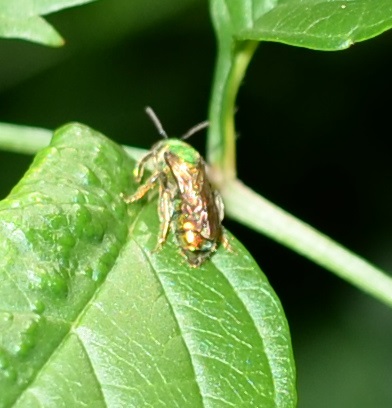
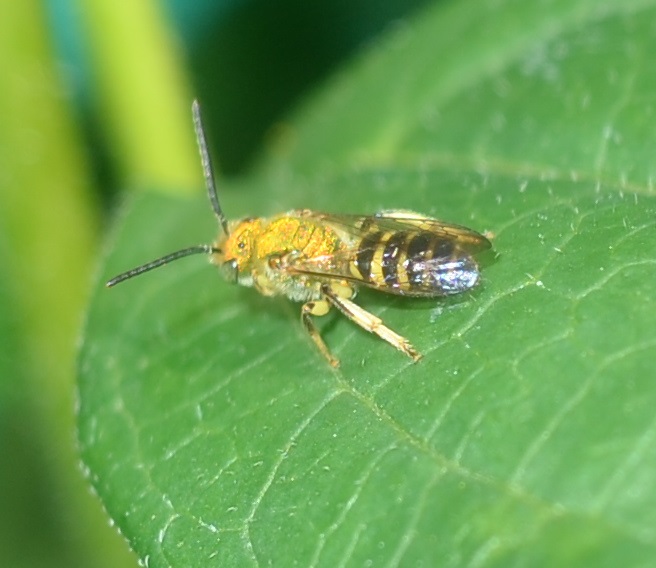
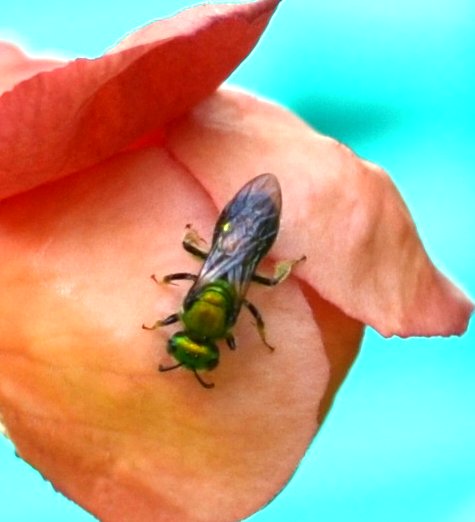
Only one ichneumon. This one was on the shop wall (dark east side) and really hated a camera. The next image looks like a bee, but is really an apoid (bee-like) wasp.
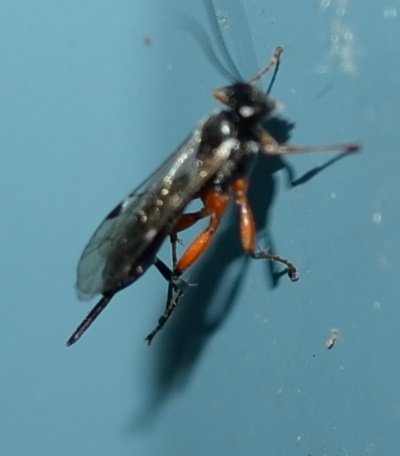
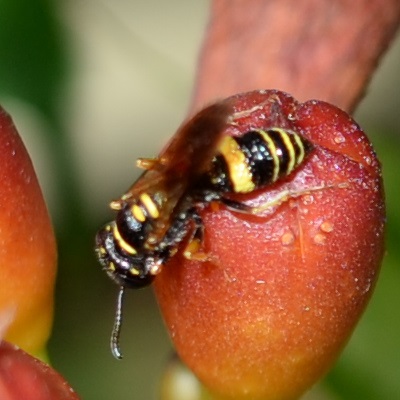
This gorgeous yellow beetle homed in on the matching gloriosa daisy. Other people who have black-eyed susans also have lots of these visiting. My neighbor
around the corner had this beautiful blue [what I can only guess is] a beetle. And that is all the beetles that surfaced this week except for an ever-growing number of ladybirds. The red ones - they eat their weight in littler bugs.
;
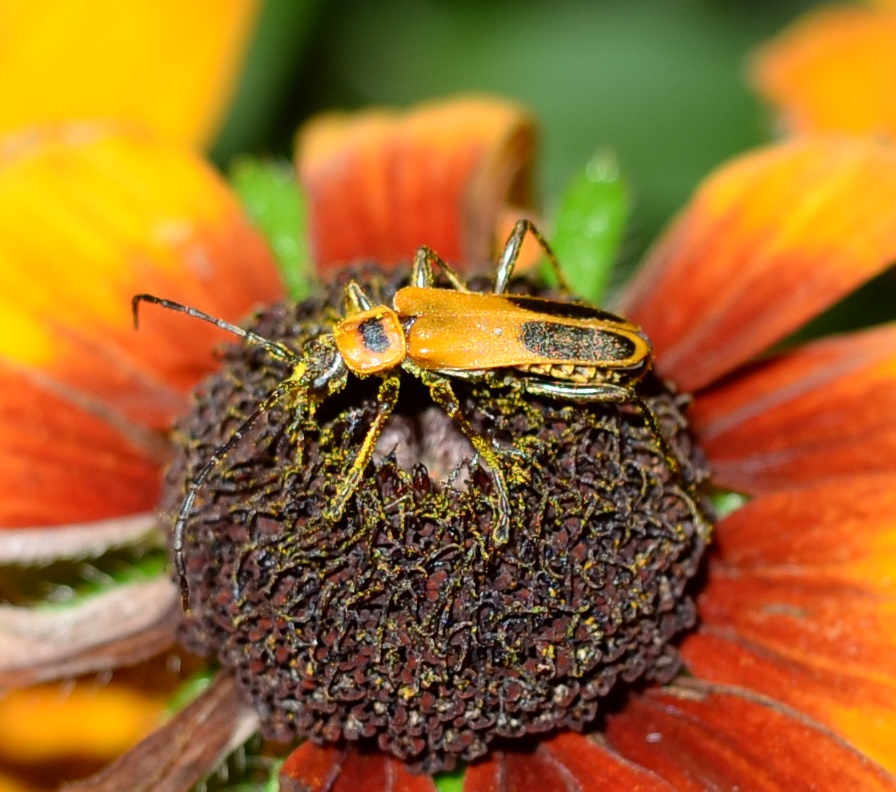

The flies are still with us. Here is the big scary one that everyone thinks is an abomination. I think he's saying, "Chess, anyone?". This tiny tiny one looks just like a transistorized house fly. This orange one also resembles the house fly, but isn't it pretty in its gold garb? Lastly, the mosquito that didn't bite me.
;
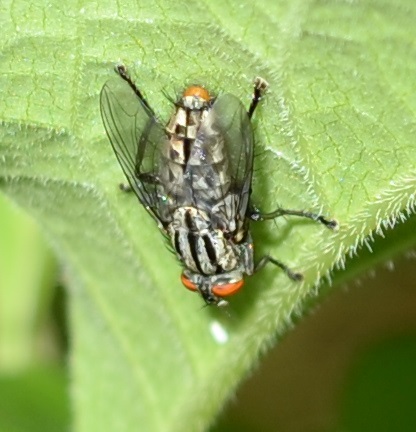
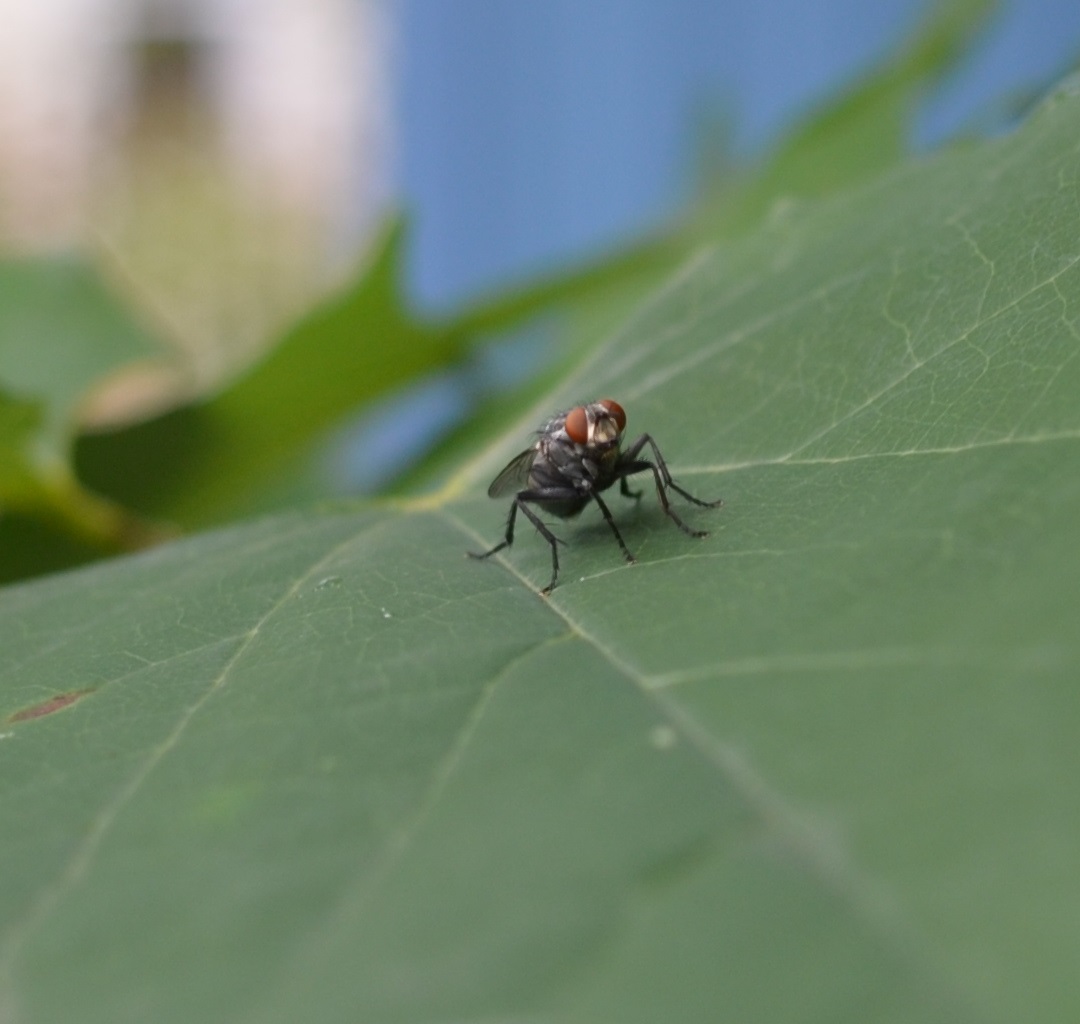
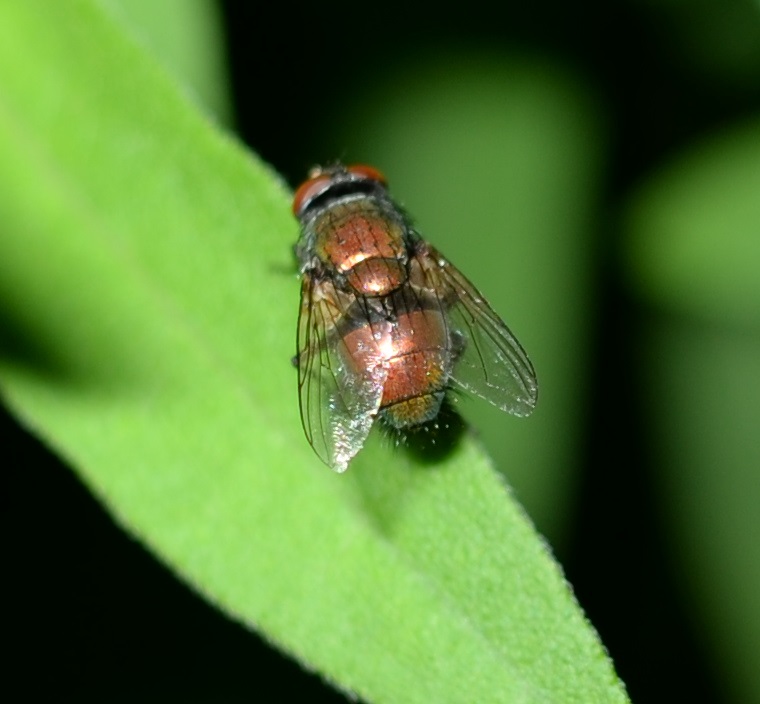
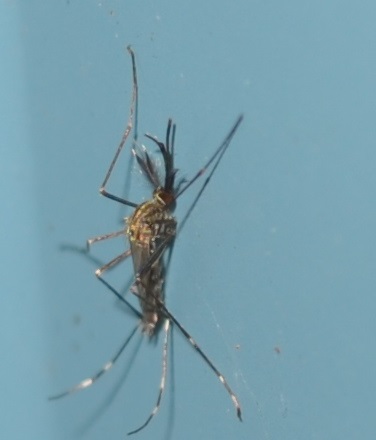
Now for some of the more exotic flies. First is the picture-winged fly, of which I don't think I ever caught the face view before. It almost looks like a horse. The scorpion fly keeps its tail rolled up but until now I'd never realized how MUCH it looks like a cocked scorpion tail. But its nose is, like the picture-winged fly, long and horsy. Here's that hover fly that has been hovering since early on, and here is a picture of a golden fly with lovely black and clear wings hiding behind a stem. Finally -- the robber fly against the light showing off the white tummy hairs that give it away as belonging to the genus Efferia.
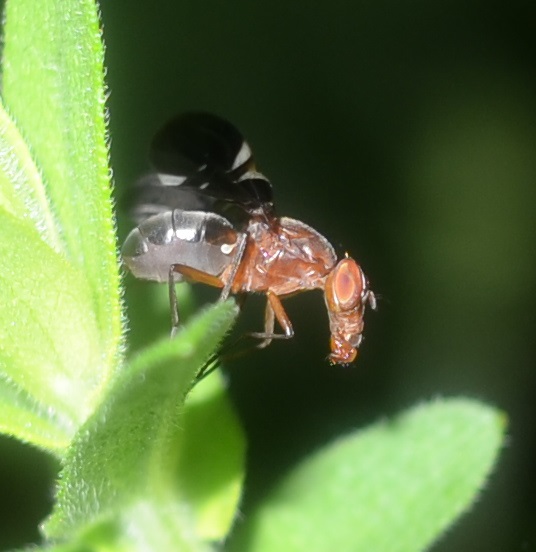
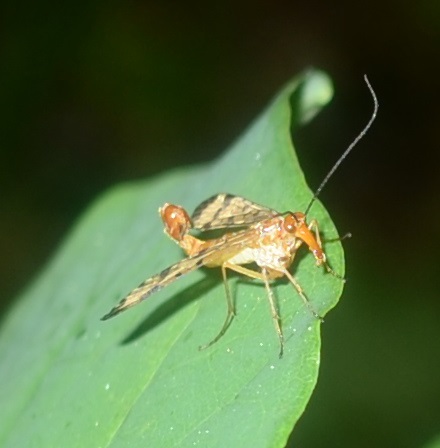
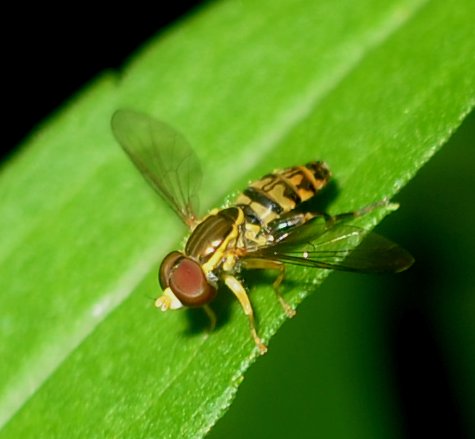
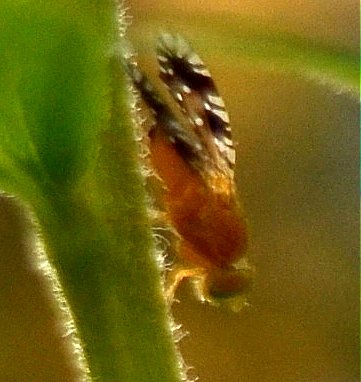
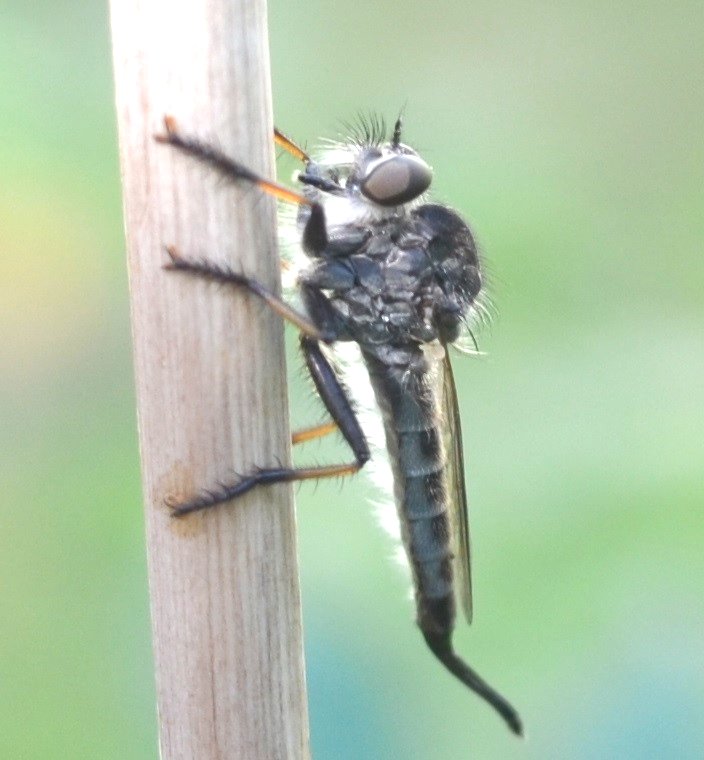
This crane fly may just be the smallest one I've ever seen, at just about an inch of length (not counting those legs!). This blue and gold one is pretty, and so is this gold on gold. But look what happens when you use the flash!
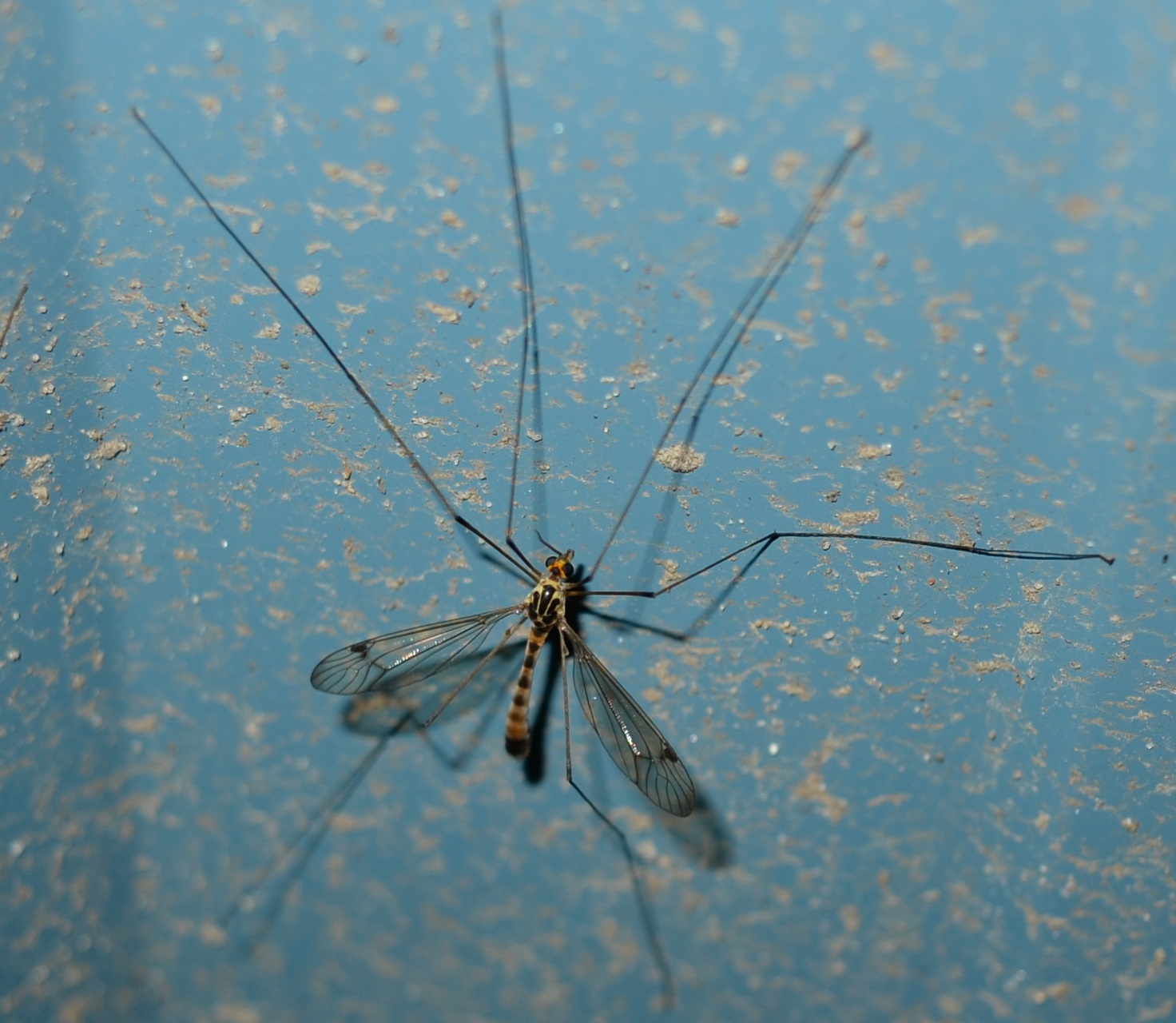
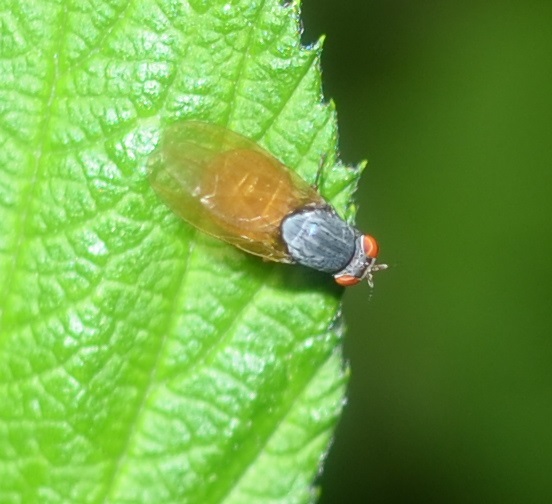
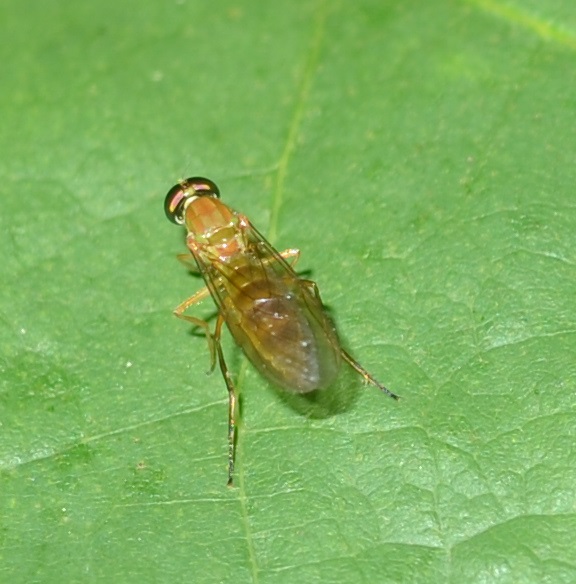
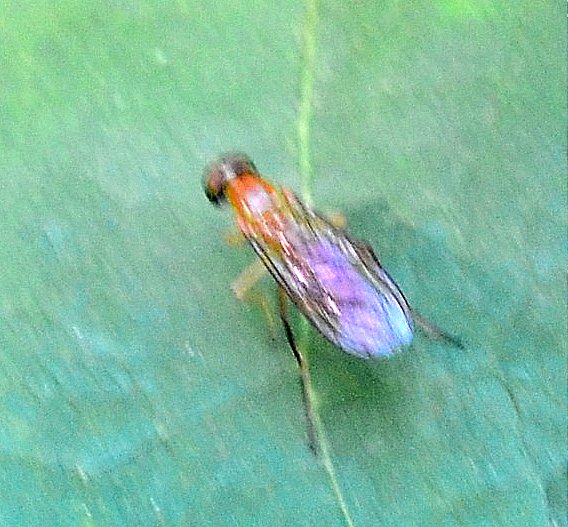
I did it again! I couldn't find this leafhopper and so submitted it for identification. This is the second time I've misidentifiel something as a beetle, or in this case, as a leafhopper, and it turns out to be a bark louse, a different one from before. It's Cerastipsocus venosus. Since we're talking about one-offs, here is a baby tree frog like the ones we had before, but tbis one has grown greatly. It's about an inch and a quarter and looks bigger than that, and is ensconced in a tall weed in the weed patch.
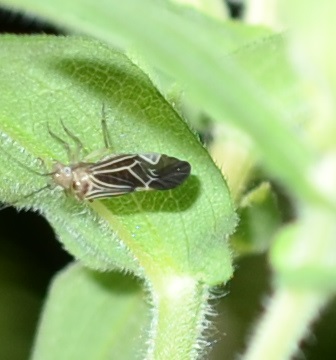
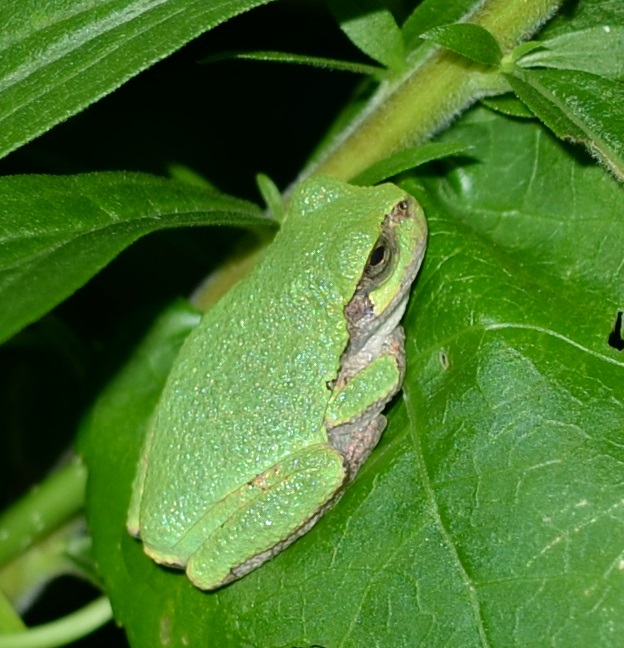
Now I know I told about some of the moths at the very beginning. Like all my friends, who go on and on about their grandkids, I love to talk about the baby imperials. But we've had a little bit of other Lepidopteran action. A Monarch flitted past me in the yard yesterday. That hickory tussock moth baby is still out there near the shed, and now has a bit of the black tufts it was missing before and which was all it needed for a positive identification. We also had quite a few small moths of the grey or off-white variety like this tiny one. The funniest one of all is this one that was among the redbuds. It looks (to me) like a paper plane. Here are two views. The last image is of the only butterfly I caught on the coneflower this week. It is of coure the silver-spotted skipper.
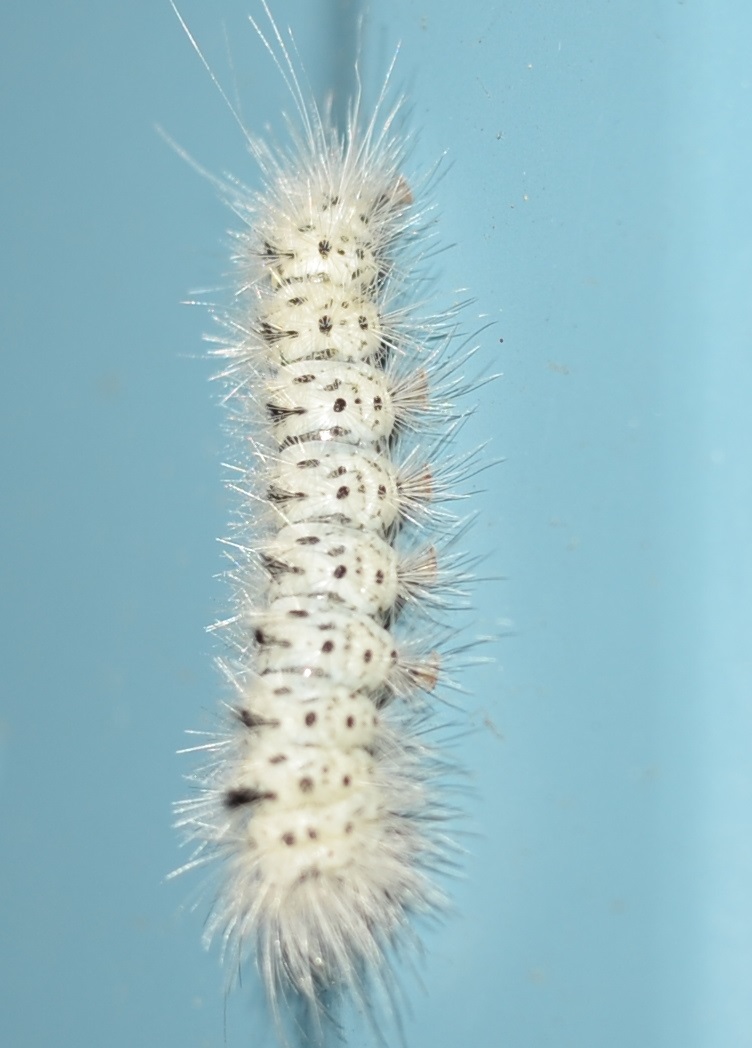

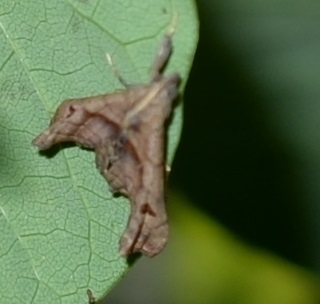
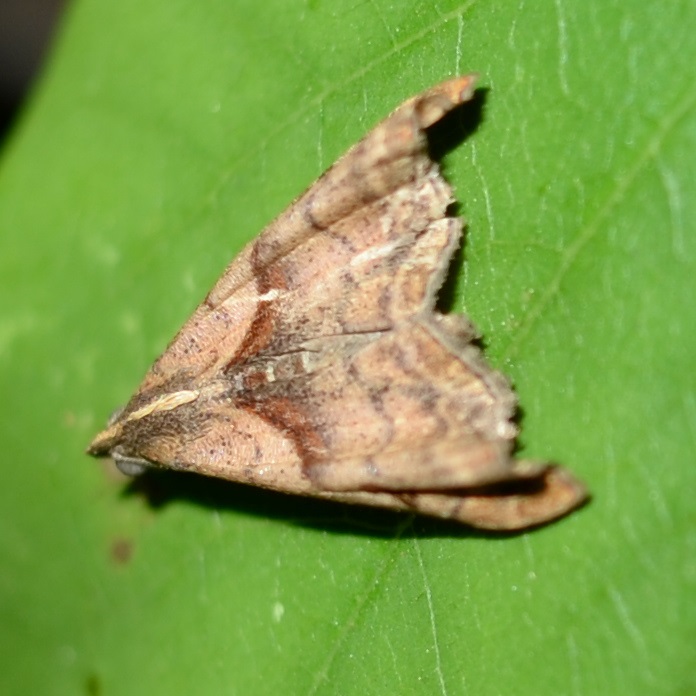
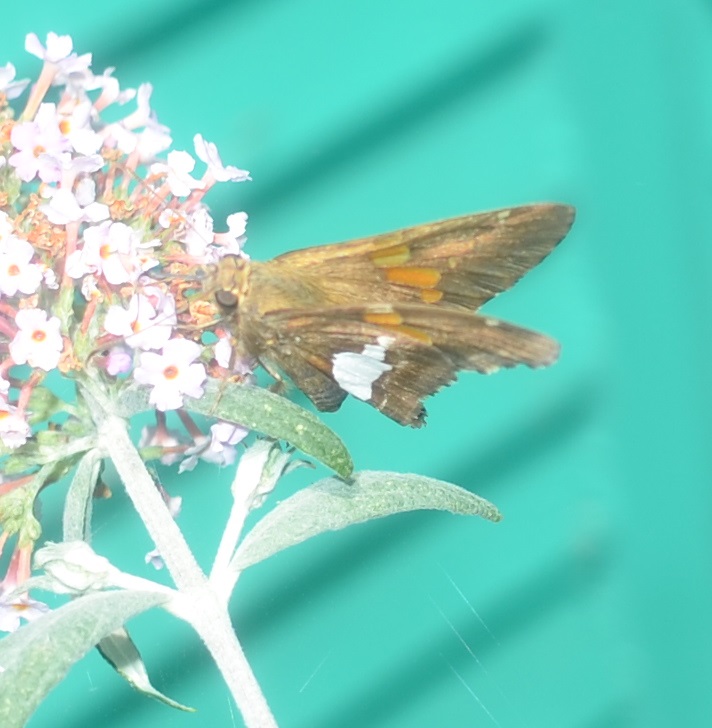
We were a bit short on spiders last week, but I peered around extra hard this week to ferret out a few for you. Some are old friends, but a few may be new acquaintances. Of course there were a few common house spiders. i called this big fat grey one a ground crab spider, but now I think I'm wrong. It didn't seem to have a web except for a silk thread that it used to navigate up and down in the air. The next one reminded me of something. Yes, the pattern reminded me of the so-called pirate spiders. There were numerous little crab spiders, and I do mean little. Maybe I should say minuscule. Some are in the cones of conflowers. Some are hiding in the asters even though the flowers they inhabit aren't developed yet. Here is one in the head of a dying cone flower -- with an enormous fly. It never lost control of the fly even though the camera came at it from all directions! This last one is a tiny thing on a raspberry leaf. It is most certainly not a crab spider because all its legs are splayed out evenly on the leaf.

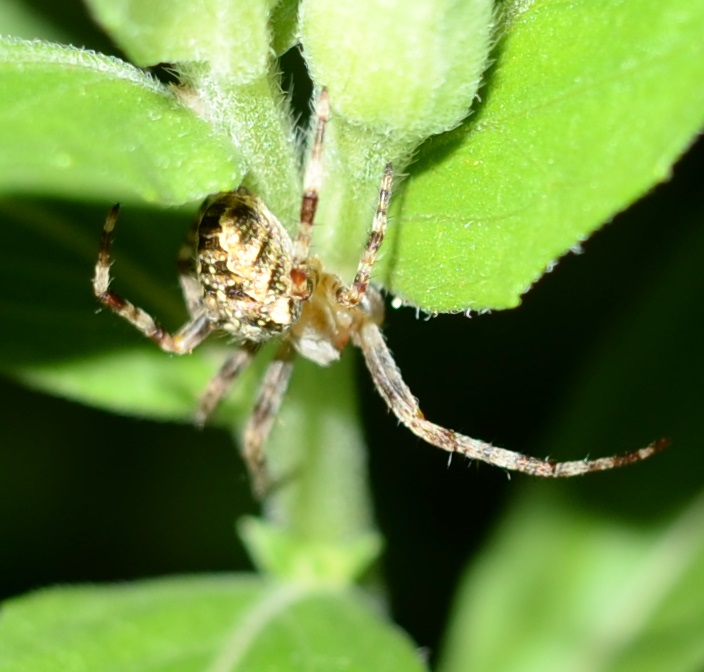
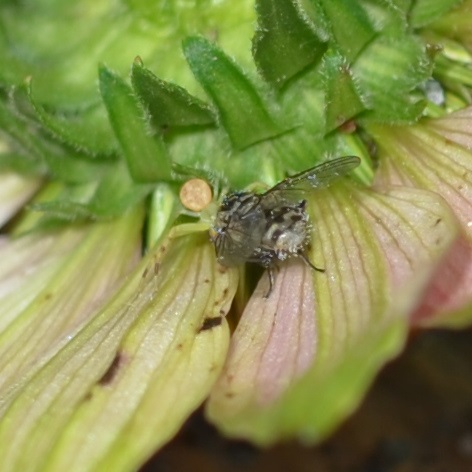
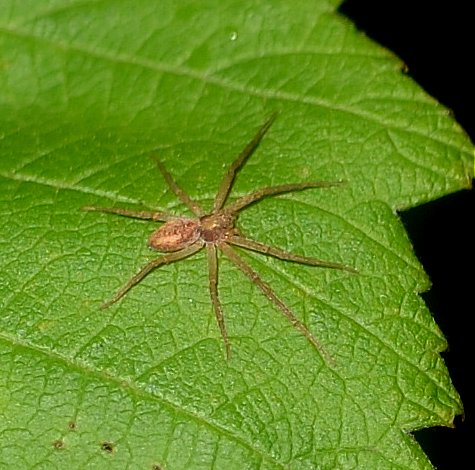
And that is almost everything I saw this week. The rain has been off for awhile, so I do spend a bit of time watering, trying to keep the plants alive and the pond full-ish. You can open the windows almost every evening and blow the cooler air into the house. There is a bit of a hint that autumn will be coming. I always think of the asters and goldenrod as a harbinger of fall. And they are at hand already, just waiting to bloom! If you are in this hemisphere, welcome!
Keep well and happy. Take care now, see you next week!
Back to August 2
On to August 16
Back to 2015 menu
Back to main menu
copyright Martha O'Kennon 2015












 on lantana- 8 3 15 1a.jpg)






















































